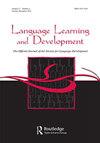How Adults and Children Interpret Disjunction under Negation in Dutch, French, Hungarian and Italian: A Cross-Linguistic Comparison
IF 1.5
2区 文学
0 LANGUAGE & LINGUISTICS
引用次数: 3
Abstract
ABSTRACT In English, a sentence like “The cat didn’t eat the carrot or the pepper” typically receives a “neither” interpretation; in Japanese it receives a “not this or not that” interpretation. These two interpretations are in a subset/superset relation, such that the “neither” interpretation (strong reading) asymmetrically entails the “not this or not that” interpretation (weak reading). This asymmetrical entailment raises a learnability problem. According to the Semantic Subset Principle, all language learners, regardless of the language they are exposed to, start by assigning the strong reading, since this interpretation makes such sentences true in the narrowest range of circumstances.). If the “neither” interpretation is children’s initial hypothesis, then children acquiring a superset language will be able to revise their initial hypothesis on the basis of positive evidence. The aim of the present study is to test an additional account proposed by Pagliarini, Crain, Guasti (2018) as a possible explanation for the earlier convergence to the adult grammar by Italian children. The hypothesis tested here is that the presence of a lexical form such as recursive né that unambiguously conveys a “neither” meaning, would lead children to converge earlier to the adult grammar due to a blocking effect of the recursive né form in the inventory of negated disjunction forms in a language. We compared data from Italian (taken from Pagliarini, Crain, Guasti, 2018), French, Hungarian and Dutch. Dutch was tested as baseline language. French and Hungarian have – similarly to Italian – a lexical form that unambiguously expresses the “neither” interpretation (ni ni and sem sem, respectively). Our results did not support this hypothesis however, and are discussed in the light of language-specific particularities of the syntax and semantics of negation.成人和儿童如何理解荷兰语、法语、匈牙利语和意大利语中否定下的分离:跨语言比较
在英语中,像“猫没有吃胡萝卜或辣椒”这样的句子通常会被理解为“两者都不是”;在日语中,它得到了“不是这个,不是那个”的解释。这两种解释是在一个子集/超集关系中,因此“非”解释(强阅读)不对称地需要“不是这个或不是那个”解释(弱阅读)。这种不对称的蕴涵引发了一个易学性问题。根据语义子集原则,所有的语言学习者,无论他们接触的语言是什么,都是从分配强阅读开始的,因为这种解释使这样的句子在最狭窄的情况下是正确的。如果“两者都不是”的解释是儿童的初始假设,那么获得超集语言的儿童将能够在积极证据的基础上修正他们的初始假设。本研究的目的是验证Pagliarini, Crain, Guasti(2018)提出的另一种解释,即意大利儿童较早向成人语法趋同的可能解释。这里测试的假设是,由于递归n形式在语言中否定析取形式的列表中的阻塞效应,诸如递归n形式这样明确表达“neither”意思的词汇形式的存在,会导致儿童更早地收敛于成人语法。我们比较了意大利语(取自Pagliarini, Crain, Guasti, 2018)、法语、匈牙利语和荷兰语的数据。荷兰语被测试为基准语言。与意大利语类似,法语和匈牙利语有一种明确表达“neither”解释的词汇形式(分别是ni ni和sem sem)。然而,我们的结果并不支持这一假设,并根据语言的语法和语义的特殊性进行了讨论。
本文章由计算机程序翻译,如有差异,请以英文原文为准。
求助全文
约1分钟内获得全文
求助全文

 求助内容:
求助内容: 应助结果提醒方式:
应助结果提醒方式:


